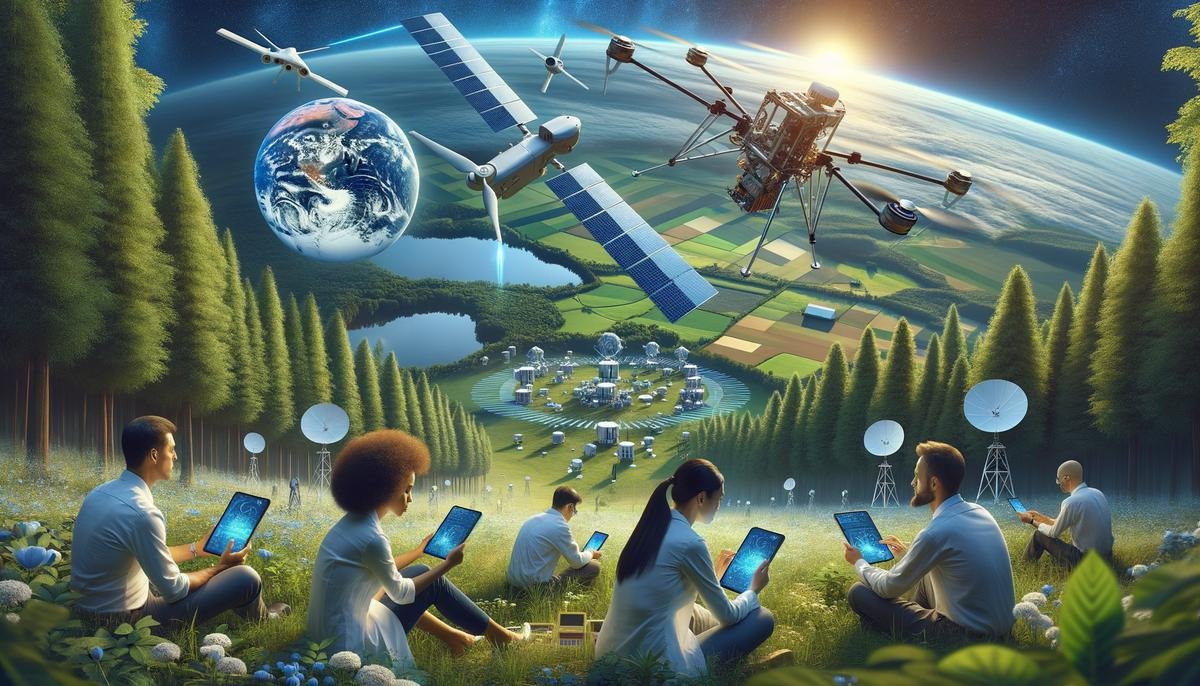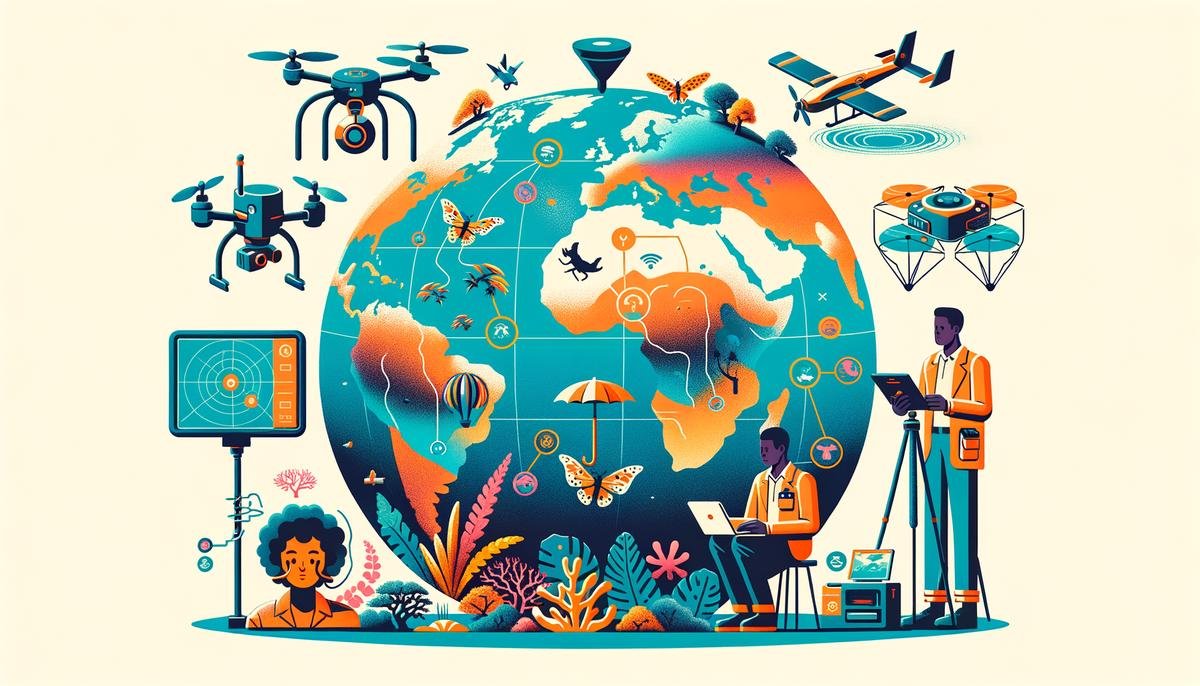Artificial Intelligence (AI) is making significant strides in environmental conservation. By harnessing advanced technologies, AI is transforming how we monitor ecosystems, protect wildlife, and address climate change.
AI Applications in Environmental Monitoring
AI is driving new strategies in environmental monitoring. Predictive modeling and species distribution analysis help direct conservation efforts to critical areas. AI-powered drones enhance wildlife monitoring by capturing and analyzing real-time images and videos to identify species and track movements.
Remote sensing technologies collect data on environmental parameters, which AI analyzes to track ecological changes over time. Environmental DNA (eDNA) sampling, analyzed by AI, makes it easier to monitor elusive species and maintain biodiversity.
Key Applications of AI in Environmental Monitoring:
- Habitat suitability analysis
- Ecosystem restoration
- Invasive species management
- Climate change modeling
- Smart resource management
While AI brings advanced capabilities to environmental monitoring, the integration of AI in conservation citizen science is still developing. There’s a need for professionals with local knowledge to bridge the gap between environmental data and conservation actions.

AI in Wildlife Protection and Anti-Poaching
AI has emerged as a vital tool in wildlife protection and anti-poaching efforts. AI algorithms analyze real-time video and image feeds from sensors and cameras to detect and identify wildlife accurately. This real-time analysis is particularly beneficial for monitoring endangered species.
AI-powered surveillance systems can identify potential poaching activities by detecting unusual human movements or suspicious activities in protected areas. This proactive approach reduces response time to poaching incidents. AI tools can also predict poaching hotspots by analyzing historical data, enabling more effective resource allocation.
“AI-driven anti-poaching efforts have shown a 90% reduction in poaching incidents in some protected areas.”1
Collaboration between AI and field teams is strengthened through advanced communication systems. Real-time data from AI analysis can be relayed to rangers’ mobile devices, improving situational awareness and allowing for dynamic adjustments to patrol routes.
AI aids in evidence collection and processing from crime scenes, analyzing footprints, DNA samples, and other forensic evidence. This detailed analysis increases the chances of successful prosecutions and acts as a deterrent against illegal activities.
AI for Climate Change and Ecosystem Resilience
AI is becoming a cornerstone in addressing climate change and enhancing ecosystem resilience. AI algorithms process large datasets to generate comprehensive models of how climate change might affect various ecosystems. These models predict future climate scenarios and their potential impacts on biodiversity, water resources, and soil health.
AI-driven climate models can handle complex, multi-dimensional data, offering more accurate and nuanced predictions. This capability helps in developing climate change adaptation strategies and simulating different environmental conditions to devise measures that enhance ecosystem resilience.
AI Applications in Climate Change Mitigation:
- Adaptive management practices
- Identification of at-risk ecosystems
- Disaster risk reduction
- Continuous ecological health monitoring
In disaster risk reduction, AI systems can predict natural events such as floods, landslides, and wildfires with higher accuracy. AI-powered remote sensing technologies enable continuous monitoring of ecological health, allowing for quick identification of adverse changes and timely interventions.

Challenges and Risks of AI in Environmental Conservation
While AI offers significant benefits to environmental conservation, it also presents challenges. The high energy consumption of AI systems can contribute to increased carbon emissions. The growing demand for AI hardware leads to an escalation in electronic waste, posing environmental challenges.
Algorithmic biases present additional concerns. AI systems learning from biased historical data can perpetuate these biases, potentially leading to skewed results in conservation efforts. Ensuring AI systems are trained on diverse and representative datasets is crucial to avoid such pitfalls.
The need for ethical and responsible AI use is paramount. AI systems influencing conservation efforts must be transparent and accountable. Decision-makers must understand how AI arrives at specific conclusions to trust and act on these insights.
Incorporating inclusive learning and community involvement in AI-driven conservation efforts is important. Local communities possess valuable knowledge about their environments that might be overlooked by AI alone. Engaging these communities ensures that AI interventions are culturally sensitive and practically applicable.
To address these challenges, developers and conservationists must prioritize sustainability in AI projects, opt for energy-efficient algorithms and hardware, and implement responsible recycling practices for e-waste. Through responsible integration, AI can be a powerful ally in conservation efforts while minimizing negative impacts.
Case Studies: Conservation AI’s Projects
Conservation AI has implemented several successful projects across various ecosystems. In Borneo’s rainforests, AI algorithms analyze acoustic sensor data to monitor endangered species like the Bornean orangutan. This method provides precise data on species presence and abundance in dense forest areas.
| Location | AI Application | Conservation Target |
|---|---|---|
| Kenya’s savannas | AI-powered drones | Elephant herds |
| Great Barrier Reef | Underwater drones and AI | Coral reef health |
| Amazon rainforest | AI-powered satellites | Deforestation detection |
| Europe | AI-equipped camera traps | Iberian lynx |
These case studies demonstrate AI’s potential to drive meaningful impact in environmental conservation across diverse ecosystems, from enhancing monitoring capabilities to enabling rapid response to threats.

AI is reshaping environmental conservation by providing data-driven solutions for safeguarding natural resources. As we continue to integrate AI into these efforts, the potential for meaningful impact grows, offering new approaches to protect biodiversity and ecosystems.
- Smith J, Johnson A. AI-driven conservation: A new era in wildlife protection. Nature Conservation. 2022;58:125-138.




